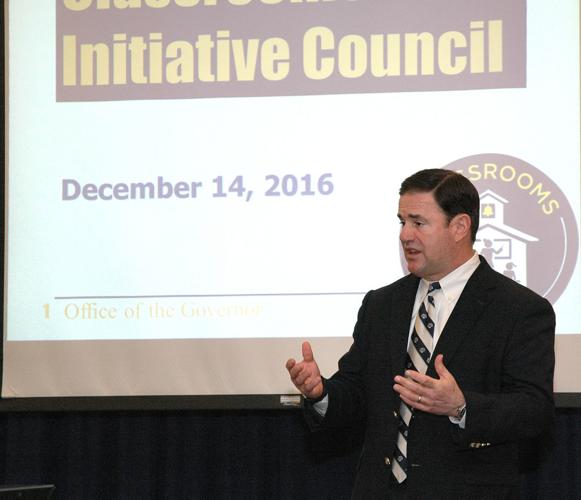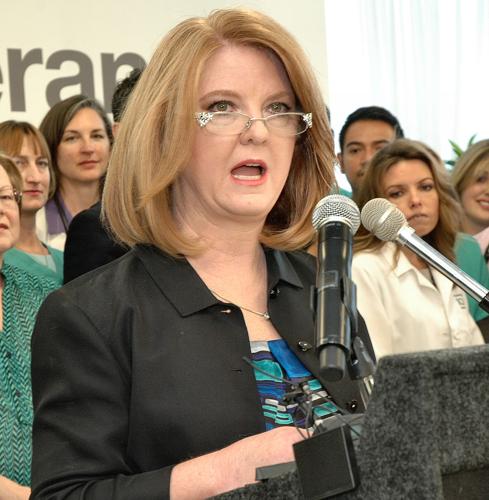PHOENIX — A task force is recommending higher teacher pay, more money for schools with a high number of students in poverty and a more “predictable and equitable” funding system among schools.
And no ideas on how to finance any of that.
The report, issued Wednesday, also includes a recommendation that schools be given more flexibility to use the dollars they do get. And it seeks more financial transparency so parents can see how schools spend their money.
That lack of recommendations on how to fund any of that was by design. Jim Swanson, who chairs the Classrooms First Initiative Council, said Gov. Doug Ducey specifically left that out of what he asked committee members to study when he created the task force shortly after taking office in January 2015.
Ducey, speaking with reporters outside the council’s final meeting, said he is working on plans for new dollars. He said, though, he’s not ready to provide details.
“We’re going to have an exciting education agenda this year,” the governor said. “And you’re going to hear about it in the State of the State” address.
Some lawmakers, however, are not waiting to see how much Ducey is offering in additional money for a statewide school system is consistently in the bottom 10 percent nationally in per-pupil funding.
State Rep. Heather Carter, R-Cave Creek, told Capitol Media Services on Wednesday she is working on a “grand plan” to infuse major new dollars into not just K-12 education but also what she believes is an underfunded university and community college system.
Carter said Arizona education needs more than anything Ducey could propose within the confines of the state’s existing revenue stream.
“I think it’s time for us to have big, bold conversations about what the next steps are for education in Arizona,” she said.
Carter acknowledged generating the kind of money she and other legislators believe is necessary will require major new tax revenues. A 1-cent increase in the state’s 5.6 percent sales tax rate would generate about $1 billion a year.
The idea of a big tax hike could run into opposition from Ducey, who won election in 2014 on a promise of proposing tax cuts every year he is in office. But his feelings may be irrelevant.
Carter said the only way Arizona has historically made significant increases in education funding is by taking the issue directly to voters, a move that bypasses the governor. And she said her plan is no exception.
With approval of her colleagues, that could put the issue on the ballot in 2018 — if not earlier at a special election.
Carter said some details are being worked out. But she said a key component will be new dollars for teacher pay — a key issue the council said needs attention .
Carter also wants to ask voters to continue a six-tenths of a cent sales tax hike they approved in 2000 specifically earmarked for teacher salaries. That levy — and the $600 million a year it generates — self-destructs in 2021 unless renewed.
Ducey, for his part, is in no particular hurry, saying there is plenty of time to deal with that issue. And the governor brushed aside reports putting Arizona near the bottom of what it spends on its students.
“I think it’s important that we measure our success in results and outcomes that use available dollars to improve those for all of our kids,” he said.
He bristled when pushed about Arizona’s rankings.
“I’m saying that there’s lies, damned lies and statistics,” Ducey responded, quoting a line popularized by Mark Twain .
The hot-button item appears to be teacher salaries.
“The council believes that Arizona needs committed individuals who want to be teachers, who are good at their jobs and who want to stay in the profession for a long time,” Wednesday’s report says.
It says council members heard from teachers that “they want their profession elevated to high regard, they want to be paid fairly, and they want support and training to do their jobs well.”
Not spelled out is how much is needed.
The most recent figures from the National Education Association show average teacher pay in Arizona at $45,477, compared with $58,064 nationally.
With more than 12,000 teachers here, bringing the average here up to the national figure could cost as much as $750 million.
State schools Superintendent Diane Douglas was more conservative in her own recommendations issued last month: $140 million in new money for each of the next three years.
Douglas said that without new funding, the state is stuck with a system where 20 percent of new teachers leave in the first year and another 20 percent quit the second year.
While Ducey has yet to spell out how much he wants, the governor said he agrees with the goal.
“There’s nothing more important in our K-12 education system,” he said. “We know that makes the biggest difference along with the principals that lead the schools.”
Carter said she not only wants more money overall for teachers but a special stipend for “high-performing teachers.”
“We want to make sure we’re doing everything we can to attract and retain the best and the brightest teachers in all of our classrooms, from early childhood to the university,” she said.
Carter said she can make the case that more funding.
“When we’re looking at attracting more business to Arizona and providing the supports for the businesses who are already here to continue to grow and thrive, all roads lead to a highly qualified, educated workforce,” she said.
Carter said the findings of council members will help smooth the way for what she intends to propose, even without recommendations for a funding source.
“Their work over the last two years has set the foundation for what we need to do next,” she said.





